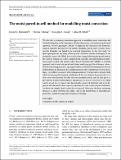Files in this item
The moist parcel-in-cell method for modelling moist convection
Item metadata
| dc.contributor.author | Dritschel, D. G. | |
| dc.contributor.author | Böing, S. J. | |
| dc.contributor.author | Parker, D. J. | |
| dc.contributor.author | Blyth, A. M. | |
| dc.date.accessioned | 2018-10-19T08:30:07Z | |
| dc.date.available | 2018-10-19T08:30:07Z | |
| dc.date.issued | 2018-10-04 | |
| dc.identifier | 252962614 | |
| dc.identifier | 04311333-8bd4-44c6-8405-c67fb11c5657 | |
| dc.identifier | 85054542794 | |
| dc.identifier | 000448651000002 | |
| dc.identifier.citation | Dritschel , D G , Böing , S J , Parker , D J & Blyth , A M 2018 , ' The moist parcel-in-cell method for modelling moist convection ' , Quarterly Journal of the Royal Meteorological Society , vol. 144 , no. 715 , pp. 1695-1718 . https://doi.org/10.1002/qj.3319 | en |
| dc.identifier.issn | 0035-9009 | |
| dc.identifier.other | ORCID: /0000-0001-6489-3395/work/64697821 | |
| dc.identifier.uri | https://hdl.handle.net/10023/16286 | |
| dc.description | The authors gratefully acknowledge support for this research from the EPSRC Maths Foresees Network. The numerical model development was carried out under the grant “A prototype vortex-in-cell algorithm for modelling moist convection” from March to October 2016. Steven Böing is partially funded through the NERC/Met Office Joint Programme on Understanding and Representing Atmospheric Convection across Scales (GENESIS, grant number NE/N013840/1). Doug Parker is supported by a Royal Society Wolfson Research Merit Award. | en |
| dc.description.abstract | We describe a promising alternative approach to modelling moist convection and cloud development in the atmosphere. Rather than using a conventional grid‐based approach, we use Lagrangian “parcels” to represent key dynamical and thermodynamical variables. In the prototype model considered, parcels carry vorticity, mass, specific humidity, and liquid‐water potential temperature. In this first study, we ignore precipitation, and many of these parcel “attributes” remain unchanged (i.e. are materially conserved). While the vorticity does change following the parcel motion, the vorticity tendency is readily computed and, crucially, unwanted numerical diffusion can be avoided. The model, called “Moist Parcel‐In‐Cell” (MPIC), is a hybrid approach which uses both parcels and a fixed underlying grid for efficiency: advection (here moving parcels) is Lagrangian whereas inversion (determining the velocity field) is Eulerian. The parcel‐based representation of key variables has several advantages: (a) it allows an explicit subgrid representation; (b) it provides a velocity field which is undamped by numerical diffusion all the way down to the grid scale; (c) it does away with the need for eddy viscosity parametrizations and, in their place, it provides for a natural subgrid parcel mixing; (d) it is exactly conservative (i.e. there can be no net loss or gain of any theoretically conserved attribute); and (e) it dispenses with the need to have separate equations for each conserved parcel attribute; attributes are simply labels carried by each parcel. Moreover, the latter advantage increases as more attributes are added, such as the distributions of microphysical properties, chemical composition and aerosol loading. | |
| dc.format.extent | 25672468 | |
| dc.language.iso | eng | |
| dc.relation.ispartof | Quarterly Journal of the Royal Meteorological Society | en |
| dc.subject | Clouds | en |
| dc.subject | Convection | en |
| dc.subject | Numerical method | en |
| dc.subject | GE Environmental Sciences | en |
| dc.subject | QA75 Electronic computers. Computer science | en |
| dc.subject | NDAS | en |
| dc.subject.lcc | GE | en |
| dc.subject.lcc | QA75 | en |
| dc.title | The moist parcel-in-cell method for modelling moist convection | en |
| dc.type | Journal article | en |
| dc.contributor.sponsor | EPSRC | en |
| dc.contributor.institution | University of St Andrews. Applied Mathematics | en |
| dc.contributor.institution | University of St Andrews. Marine Alliance for Science & Technology Scotland | en |
| dc.contributor.institution | University of St Andrews. Scottish Oceans Institute | en |
| dc.identifier.doi | https://doi.org/10.1002/qj.3319 | |
| dc.description.status | Peer reviewed | en |
| dc.date.embargoedUntil | 2018-10-04 | |
| dc.identifier.grantnumber | RG.MATH.103301 | en |
This item appears in the following Collection(s)
Items in the St Andrews Research Repository are protected by copyright, with all rights reserved, unless otherwise indicated.

